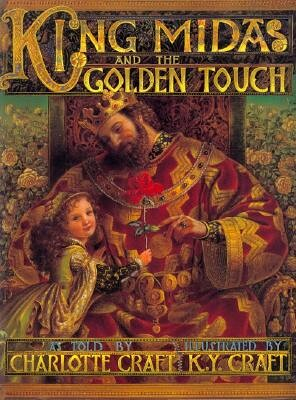Title of the work
Country of the First Edition
Country/countries of popularity
Original Language
First Edition Date
First Edition Details
Charlotte Craft, King Midas and the Golden Touch. HarperCollins, New York, 1999, 32 pp.
ISBN
Genre
Adaptations
Myths
Target Audience
Children (4–8 years)
Cover

Cover uploaded by cea +, retrieved from flickr.com. Licensed under CC BY 2.0 (all links accessed: January 7, 2022).
Author of the Entry:
Ayelet Peer, Bar-Ilan University, ayelet.peer@gmail.com
Peer-reviewer of the Entry:
Lisa Maurice, Bar-Ilan University, lisa.maurice@biu.ac.il
Susan Deacy, Roehampton University, s.deacy@roehampton.ac.uk

Charlotte Craft (Author)
Charlotte Craft is an American author. She studied comparative literature at Columbia University in New York.
Source:
Profile at harpercollins.com (accessed: January 21, 2020)
No further information was available (January 2020)
Bio prepared by Ayelet Peer, Bar-Ilan University, ayelet.peer@gmail.com

Kinuko Y. Craft (Illustrator)
Kinuko Y. Craft is a highly-respected fantasy illustrator in the USA. She considers herself a story teller. Born in Japan, she graduated in 1962 from The Kanazawa Bidai, the Kanazawa Municipal College of Fine and Industrial Art. She studied design and illustration at the Art Institute of Chicago. Her work has gained appraisal from professional art and design publications, and has won many awards.
Source:
Profile at borsini-burr.com (accessed: February 20, 2019)
Bio prepared by Ayelet Peer, Bar-Ilan University, ayelet.peer@gmail.com
Summary
The book follows the myth of King Midas’ golden touch with lavish illustrations. The author follows the well-known tale of the King’s avarice until his golden touch affected his own life, by turning his food and daughter to gold. The illustrations are colorful, oil over watercolor, and take up an entire page.
Analysis
The page-long lavish illustrations which are oil over watercolor are an important part of this book. The illustrator notes that the author Charlotte Craft “looked to Nathaniel Hawthorne’s adaptation” for her venison of the myth. The illustrator on her part was influenced by the Middle Ages for her illustrations, especially in reference to the characters’ clothing, in order to “bring the tale just a bit closer to our own centuries.”
Thus the illustrator gives us a glimpse of the reception of the myth by both the author and herself. She also notes that each generation has its own person with a "golden touch" who must learn his lesson.
The author adds Midas’ daughter name, Aurelia, which is not a part of the original myth and is Hawthorne’s addition (in the original myth Midas did not have a daughter at all).
The author also omits the part of Dionysus and therefore her story mimics a fairy tale more than a Greek myth. In her narrative, the king finds an old man sleeping in his garden who magically transforms into a young man (who does not disclose his identity). The fairy tale likeness of the story hence correlates with the illustrations and both give the sense of later tale, not an ancient Greek myth.


